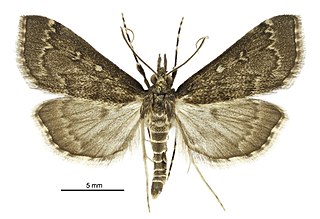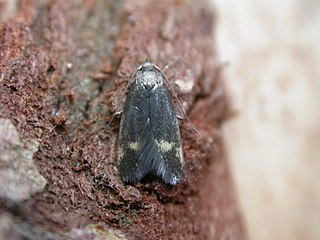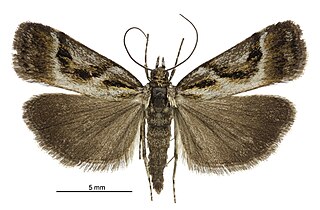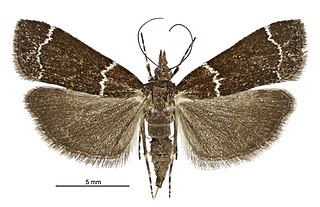
Spilomelinae is a very large subfamily of the lepidopteran family Crambidae, the crambid snout moths. They were formerly included in the Pyraustinae as tribe Spilomelini; furthermore taxonomists' opinions differ as to the correct placement of the Crambidae, some authorities treating them as a subfamily (Crambinae) of the family Pyralidae. If this is done, Spilomelinae is usually treated as a separate subfamily within Pyralidae. The Spilomelinae are believed to be polyphyletic. Many genera are only tentatively placed here even at this point.
Urodidae or "false burnet moths" is a family of insects in the lepidopteran order, representing its own superfamily, Urodoidea, with three genera, one of which, Wockia, occurs in Europe.
Deuterarcha is a genus of moths of the family Crambidae. The genus was described by Edward Meyrick in 1884.
Myriostephes is a genus of moths of the family Crambidae. The genus was erected by Edward Meyrick in 1884.

Notarcha is a genus of moths of the family Crambidae described by Edward Meyrick in 1884.

Proternia is a monotypic moth genus of the family Crambidae described by Edward Meyrick in 1884. Its only species, Proternia philocapna, described by the same author in the same year, is endemic to New Zealand.
Piletocera is a genus of moths of the family Crambidae. The genus was first described by Julius Lederer in 1863.

Austrocidaria is a genus of moths in the family Geometridae. It was described by J. S. Dugdale in 1971.

Austrocidaria parora is a species of moth of the family Geometridae. It is endemic to New Zealand. This species was described by Edward Meyrick as Harpalyce parora in 1884.

Borkhausenia is a genus of the concealer moth family (Oecophoridae) described by Jacob Hübner in 1825. Among these, it belongs to subfamily Oecophorinae, wherein it is probably closely related to Hofmannophila. In the past, several other Oecophoridae have been included in Borkhausenia, as well as a few even more distant members of the superfamily Gelechioidea. Metalampra was originally described as a subgenus of Borkhausenia. Telechrysis has also been included here as a subgenus by some, while other authors have considered it a separate genus in the Oecophorinae or – if these are also considered distinct – the Amphisbatinae.
Scenedra is a genus of snout moths described by Edward Meyrick in 1884.
Titanoceros cataxantha is a species of snout moth described by Edward Meyrick in 1884. It is found in Australia.
Musotiminae is a subfamily of the lepidopteran family Crambidae. It was described by Edward Meyrick in 1884

Eudonia hemicycla is a moth in the Crambidae family. It was described by Edward Meyrick in 1884. This species is endemic to New Zealand.

Eudonia leucogramma is a moth in the Crambidae family. This species was first described by Edward Meyrick in 1884. It is endemic to New Zealand.

Eudonia aspidota is a moth in the Crambidae family. It is found in New Zealand.
Metallarcha diplochrysa, the golden metallarcha moth, is a moth in the family Crambidae. It was described by Edward Meyrick in 1884. It is found in Australia, where it has been recorded from South Australia.

Nacoleia mesochlora is a moth in the family Crambidae. It was described by Edward Meyrick in 1884. It is found in Australia, where it has been recorded from Queensland, the Northern Territory, New South Wales, Victoria, South Australia and Western Australia.

Polylophota is a genus of snout moths. It was described by Francis Walker in 1863.

Gymnobathra is a genus of moths in the family Oecophoridae. It was first described by Edward Meyrick in 1883. All species are found in New Zealand.














